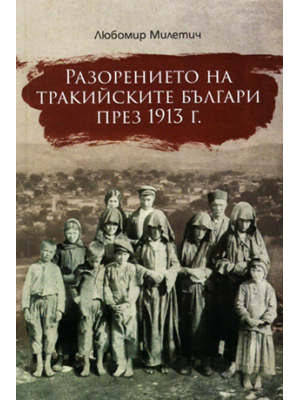Shopping Cart
0 item(s) - 0.00лв
The Bulgarians in the Easternmost Part of the Balkan Peninsula – Eastern Thrace
The Bulgarians in the Easternmost Part of the Balkan Peninsula — Eastern Thrace
Category: Modern Bulgarian History; Balkan history
Language: English
This book attempts to trace the history of Bulgarian population in Eastern Thrace. The narrative places an emphasis on the Preobrazhenie Uprising (1903) against the Ottoman Empire, organized by the Internal Macedonian-Adrianople Revolutionary Organization and on the ethnic cleansing of Bulgarians during the Second Balkan War (September 1913).
Table of contents
Black and white photos
Acknowledgements
Foreword
Reminiscence from my childhood
Prologue
Part one
Which, where and how big is the land of Eastern Thrace. Natural features
The settlement of Eastern Thrace
Trade relations in the Ottoman Empire. Basic principles of land ownership
My native village Rum begli and its vicinity
Resettlement of the Bulgarians to Rum begli in the eighteenth century. House building of the Eastern Thracian Bulgarians. More on the privileged villages
The Kurdjalii movement in Eastern Thrace
The Turkish reformist movement: Hatt-i Serif of Gulhane — 1839. Participation of the Bulgarian population in the internal struggles of the Ottoman Empire. The arson of the church in Rum begli.
The story of Dimitar the Arnaut
The Bulgarians in Eastern Thrace after the Peace Treaty of Edrine — 1829. Way of life: Economic foundation
Part two
The Crimean War (1853—1856)
Struggle for Bulgarian church and school in my native village Rum begli. Traditions and public life
Eastern Thrace: Part of the Bulgarian national revolutionary movement. The visits of Levski and Panayot Hitov. The Russian-Ottoman War (1878) and the San Stefano Peace Treaty
Protests against the decisions of the Congress of Berlin in the Lozengrad distict. The Muhadjiri issue.
The Day of the Saints Cyril and Methodius (The Day of the Slavic Enlightenment): First celebration in Eastern Thrace (11.05.1878). The first Bulgarian public speaker
Eastern Thrace between the Congress of Berlin and the Serbo-Bulgarian War (1885)
Culture and enlightenment in Eastern Thrace after the appearance of the new state of Bulgaria. The educational system in the Bulgarian schools in the Ottoman Empire
Oral sources that contributed to this work
Part three
The first organization of the Eastern Thracian emigration in Bulgaria: Felloship and Strandzha newspaper, Varna
Beginning of the Thracian revolutionary movement — arrival of Pavel Genadiev and Lazar Madjarov in Eastern Thrace. First initiations. Cheti for agitation and covering of their activity by the newspaper Strandzha
Administrative division of European Turkey. The Thessalonica Congress (1896). Unification of the Macedonia and the Thracian revolutionary movements
The visits of Gotse Delchev in Eastern Thrace. Ideological disputes between Delchev and Stojan Lazov. Unpublished memories of witnesses
Mass initiation into the cause of the national liberation and organizing of the Bulgarian population in Eastern Thrace for the forthcoming uprising
Keremidchiolu affair and its consequences
Struggle for restoration of the revolutionary organizations in Lozengrad and Buanr hisar sub-districts after the Keremidchiolu affair
Voyvoda Georgi Kondolov and his first cheta (30.05.1901)
Congrees of the Internal Macedonian-Adrianople (Edrine) Revolutionary Organizations in Plovdiv (13—15.04.1902)
The Revolutionary Organization after the Congress in Plovdiv. The meeting in Rum begli. An assault of Gergikov’s cheta on the train at the railway station Cherkeskjoy
Rum begli: Centre of Bunar hisar sub-district after Keremidchiolu affair. The tragic story of Jorgaki Pirilet. The funeral of voivodas Pano Angelov and Nikola Ravasholov in Malko Tarnovo.
The robbery and the revolutionary movement in Eastern Thrace. The execution of the four brothers from the village of Velika
How Mihail Gerdgikov reorganized the revolutionary movement in Eastern Thrace. Choosing and sending a delegate to the Congress of Thessalonica (24.01.1903)
Part four
Why the Congress of the Internal Macedonian-Adrianople (Edrine) Revolutionary Organization in Thessalonica (02—04 January 1903) solved one of the most complicated problems of Thracian revolutionary movement
The Congress of Petrova niva (28.06.1903). Division of Edrine Revolutionary Division and subdivisions
A few biographical words about Captain Stamat Ikonomov. Contradictions in the Main Battle Body in connection with the future battle actions
Appearance of the Russian naval squadron along the Strandzha coasts and the Preobrazhenie uprising
A reminiscence from the Preobrazhenie uprising
The Preobrazhenie uprisng
Subjugation of the uprising. Passage of the cheti and the population in Bulgarian
Resettlement of the regugees from Preobrazhenie uprising in Bulgaria. The amnesty and the Congress in Varna. Return to the homeland
Economic progress of the Eastern Thracian Bulgarian. How my native village Rum begli was saved from annihilation
Part five
Eastern Thrace after the Young Turk’s coup d’état (20.07.1908)
The Bulgarian-Greek struggles in Eastern Thrace in the beginning of the twentieth century. More about the origin of Captain Georgios Kondilis (1878—1936), military leader of the Greek andart cheti in Eastern Thrace
The story of voivode Todor Shishmanov
The Balkan Alliance (League) and the Balkan War for liberation as seen through the eyes of the author of this book
The war between Bulgaria and its former allies. Turkish advance and occupation of Eastern Thrace
The end
Glossary
Notes
Bibliography
Map
| Details | |
| Publisher | Orbel |
| Language | English |
| Pages | 316 |
| Illustrations | b/w figures |
| Binding | hardback |
| ISBN | 978-954-496-1107 |
| Creation date | 2014 |
| Size | 16 х 24 cm |
Write a review
Your Name:Your Review: Note: HTML is not translated!
Rating: Bad Good
Enter the code in the box below:











